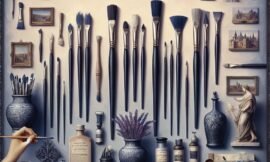In the realm of watercolor painting, the magic often begins with the right set of watercolor brushes. These essential art supplies can make a substantial difference in the texture, fluidity, and precision of your work. As any seasoned artist will tell you, selecting the perfect brushes is not just about affordability or availability, but about understanding the brush types and how they complement your artistic vision. This comprehensive guide will walk you through the nuances of choosing the ideal watercolor brushes, aiming to enhance both traditional and contemporary digital art practices.
Understanding Watercolor Brush Types
Round Brushes: Flexibility and Precision
Round brushes are beloved for their versatility. With a pointed tip, they allow artists to create fine lines, broad strokes, and everything in between. Ideal for those who enjoy detailed work, these brushes can effortlessly transition from drawing delicate petals to washing broader backgrounds.
Flat Brushes: Structural Strength and Fluidity
When you think of structural strength in art, flat brushes are the go-to option. With a broad, flat edge, they provide crisp edges and are perfect for painting straight lines or filling in larger areas with color.

Material Matters: Natural vs. Synthetic Brushes
Natural Bristles: Tradition Meets Performance
Natural bristle brushes, often made from sable or squirrel hair, are renowned for their ability to hold water and pigment. This makes them particularly suitable for traditional watercolorists who value the tactile quality these brushes provide.
Synthetic Bristles: Innovation and Affordability
For artists on a budget or those seeking eco-friendly options, synthetic brushes offer significant advantages. These brushes are often durable, easy to clean, and have improved dramatically in recent years, giving natural bristles a run for their money.
Specialty Brushes: Exploring Unique Effects
Fan Brushes: Texture and Motion
Ideal for creating textures like foliage or fur, fan brushes deliver an interesting visual variation. These brushes are excellent for adding movement to your work, ideal for both traditional and modern art applications.
Rigger Brushes: Long Lines and Details
Rigger brushes, originally devised for painting the rigging of ships, excel at making long, continuous lines. They are perfect for fine detailing, whether in the strands of hair in a portrait or the veins of a leaf.
Choosing the Right Brush Size
Large Brushes: Covering Ground
Larger brushes are integral to efficiently covering larger areas and achieving broad, sweeping washes. They are especially useful in landscape paintings where vast skies and sprawling fields dominate the composition.
Small Brushes: Precision and Detail
Smaller brushes are indispensable for achieving detail work and fine lines. They’re vital in the realm of portrait painting, architectural detailing, and any art where minute precision is paramount.
Caring for Your Brushes
Cleaning Techniques: Preserving Durability
Proper cleaning and maintenance increase the lifespan of your watercolor brushes. Rinse them with lukewarm water until it runs clear, gently reshape the bristles, and store them lying flat or hanging with bristles facing downward.
Storage Solutions: Ensuring Longevity
Store brushes in a way that protects the bristles from bending or fraying. Consider a brush holder or case that keeps them organized and protected from dust and dirt.
Trends in Watercolor Brushes for Digital Art Enthusiasts
Digital Platforms Emulating Traditional Watercolors
With the advent of tablets and styluses, digital artists can emulate watercolor techniques through software that mimics brush strokes and paint spread. Understanding traditional brush dynamics can enhance one’s digital work.
Hybrid Art: Combining Physical and Digital Mediums
Artists increasingly explore the combination of traditional watercolor with digital enhancements. This hybrid approach often involves scanning watercolor works and using digital tools for further refinement or augmentation.
In conclusion, the journey of mastering the use of watercolor brushes involves both knowledge and practice. Whether you are drawn to natural or synthetic brushes, prefer the broad strokes of a flat brush over the precision of a round one, or are experimenting with digital techniques, understanding your tools is an essential step in developing your artistry. The right brushes not only enhance your current abilities but also open avenues for exploring new creative challenges. As you grow in your art journey, remember that the brush is not merely a tool but a bridge between your thoughts and the canvas.




